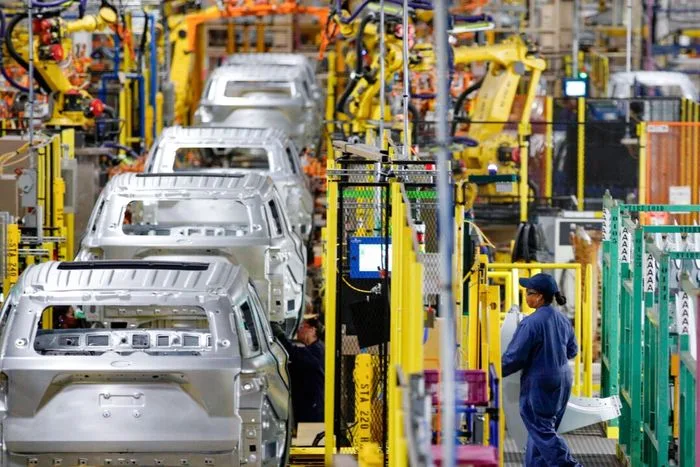By Andrew Moran
Manufacturing employment levels in New York State have declined by 45 percent since 2000, a new analysis shows.
Software services firm ETQ, using new data from the Bureau of Economic Analysis and the Bureau of Labor Statistics, determined that manufacturing jobs in the Empire State have fallen by 330,794 between 2000 and 2024.
With a 44.6 percent decline in manufacturing employment, New York State has suffered the largest percentage drop in sector payroll in the country. Other states, such as Massachusetts, Rhode Island, and Vermont, have also experienced a 40 percent decrease in manufacturing jobs.
Only a handful of states—including Alaska, Nevada, and South Dakota—have reported increases in manufacturing employment.
At the national level, the United States has lost more than 4.5 million manufacturing jobs.
While employment losses have been broad-based, they have been led by computer and electronic manufacturing (negative 786,000), printing and related support activities (negative 452,000), apparel manufacturing (negative 421,000), and machinery manufacturing (negative 350,000).
According to ETQ, the acceleration occurred between 2000 and 2010, “driven in large part by China’s entry into the World Trade Organization and the ensuing ‘China Shock.’”
By joining the international group in 2001, China gained greater access to the global market, enabling Beijing to strengthen its exports and attract more foreign investment. The transformation of global supply chains, driven by a significant surge in Chinese exports, disrupted manufacturing sectors worldwide, particularly in the United States and several European countries.
But while manufacturing employment levels have been decimated, the analysis showed that industry gross domestic product expanded from 2000 to 2024, highlighting a “disconnect between employment trends and output.”
Manufacturing Output Surges
New York State’s manufacturing output ballooned 4.7 percent over this period.
Manufacturing GDP advanced in all but four states, despite widespread job losses. In total, national manufacturing output has surged more than 45 percent since 2000.
The analysis indicated that the increase was driven by greater investments in automation, software, and advanced manufacturing processes, resulting in a reduction in manual labor.
“As a result, many states have expanded their manufacturing economies without a corresponding increase in jobs—reflecting a broader shift toward capital-intensive, technology-driven production,” the report, shared with The Epoch Times, stated.
However, while productivity has risen significantly, the industry’s contribution to overall GDP has declined over the last two decades. According to the Bureau of Economic Analysis, manufacturing’s share of GDP was below 10 percent in the first quarter, down from approximately 13 percent in 2005.
President Donald Trump’s economic agenda aims to reshape and rebalance international trade, transforming the U.S. economy into a leading global manufacturing powerhouse. During the first several months of the current administration, the United States has attracted trillions of dollars in domestic and foreign private investment, with a concentration primarily in manufacturing.
Appearing on MSNBC’s “Morning Joe” last week, Treasury Secretary Scott Bessent stated that the president’s tariffs should bolster American manufacturing over “the next couple of years.”

“We’re seeing these very large commitments both from governments and from corporates,” Bessent said in the Aug.7 interview. “We’ve got trillions and trillions of manufacturing that’s going to come back, and we’re going to see that in the next couple of years.”
Earlier this month, Apple increased its commitment to investing in the U.S. economy by $100 billion, bringing the total to $600 billion over a four-year period.
Nvidia, which was recently granted an export license to sell artificial intelligence (AI) chips to China, pledged to invest $500 billion in U.S. manufacturing. Eli Lilly, Johnson & Johnson, GE, Philips, and many others have promised to invest billions in domestic manufacturing by building factories, expanding facilities, or modernizing existing infrastructure.
Charlie Ashley, portfolio manager at Catalyst Funds, says companies will need to weigh the costs by determining whether they can absorb tariff-driven costs or reshore their manufacturing operations domestically.
“Trump’s goal is to reshore manufacturing to create jobs and use that job creation and domestic production as a tool for economic growth—keeping more of our economy and output within the country, rather than relying on foreign goods and sending money overseas,” Ashley said in a note emailed to The Epoch Times.
He added that, either way, there will be additional cost pressures, whether in the form of higher import duties or labor.
“Reshoring won’t happen overnight, and there will be some pain for corporations, as their costs will rise regardless,” Ashley said.
What Recent Data Show
So far this year, business activity in the U.S. manufacturing sector has been mixed.
The Institute for Supply Management’s widely watched Manufacturing Purchasing Managers’ Index (PMI)—a monthly report that highlights the sector’s prevailing economic trends—declined in July, marking the fifth consecutive contraction.
Likewise, the S&P Global U.S. Manufacturing PMI contracted last month for the first time since December.
“The downturn at the start of the third quarter in part reflects the passing of a busy period of tariff-related inventory accumulation in prior months,” Chris Williamson, chief business economist at S&P Global Market Intelligence, said in the July report.
Year-ahead optimism has also diminished as factories fear a reduction in demand and higher price pressures, the report stated.
Regionally, the figures have varied significantly across the Federal Reserve’s districts.
The July Philadelphia Fed Manufacturing Index registered its first positive reading since March and exceeded expectations, driven by rising new orders, shipments, and employment.
Last month, the Richmond Fed Manufacturing Index contracted for the fifth straight month and reached its lowest level in 10 months. The report highlighted decreasing manufacturing activity, ranging from a decline in new orders to a drop in shipments.





